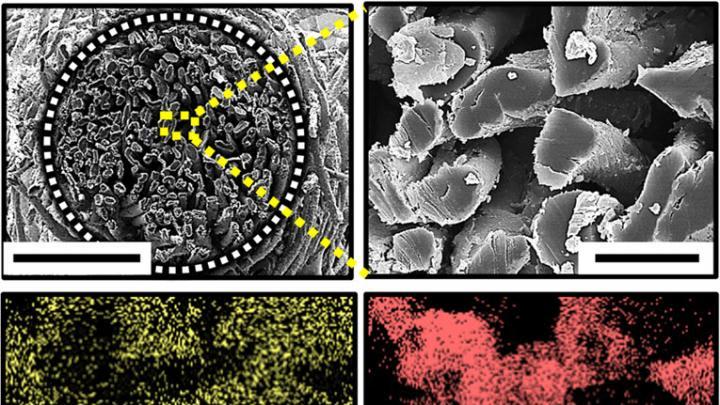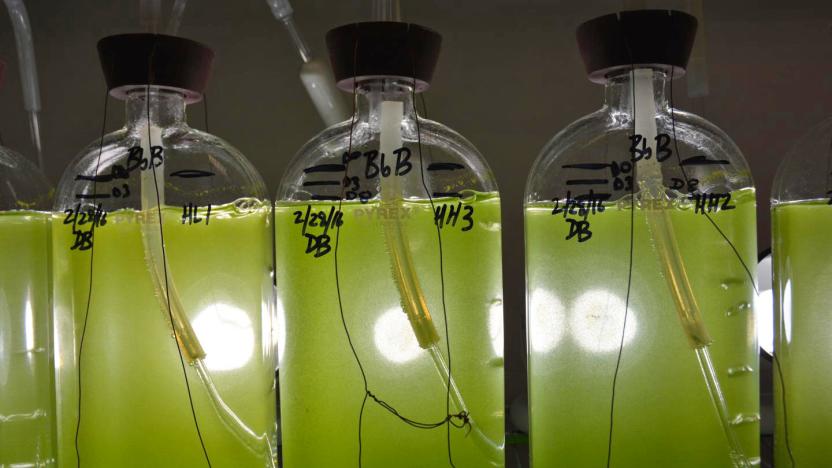biofuel
Latest

Mercedes' F1 team used biofuel to cut freight carbon emissions by 89 percent
Trucks used fuel derived from vegetable oils, waste oils and fats to move F1 cars between three grands prix.

First commercial biofuel booster rocket launches in Maine
BluShift Aerospace has successfully tes launched what it says is the first commercial biofuel booster rocket.

Researchers want to power pacemakers with cotton-based biofuel cell
Researchers at the Georgia Tech and Korea University believe they have found a way to power implantable medical devices like pacemakers with a new fuel cell made from cotton fiber. The glucose-powered biofuel cell could provide twice as much power as conventional options.

London buses to be powered by coffee grounds
As part of ongoing efforts to reduce pollution in the capital, London's buses are set to utilise a new source of fuel: coffee grounds. Thanks to a collaboration between Bio-Bean, Shell and Argent Energy, double deckers will be filled with a B20 biofuel created by blending oil extracted from coffee waste with diesel. So far, they've produced enough to power one London bus for a year, but as Londoners drink 20 million cups of coffee a day, it could provide enough oil to power a third of Transport for London's entire network.

Scientists discover shortcut for turning grass into plane fuel
It takes millions of years for natural processes to convert plants into crude oil (which is refined to gasoline), but researchers at Ghent University have figured out how to do it much faster. By pre-treating grass to make it break down quicker, and then adding Clostridium bacteria similar to that found in your gut, they produced decane, one of the main ingredients of gasoline and jet fuel. While decane is a polluting fuel, commercial jets will need it for at least the next few decades, and the researchers believe their process is efficient enough to make it commercially feasible.

Lockheed Martin's bioenergy plant turns waste into clean power
When it's not taking forever to deliver the F–35 or creating new blimp inspection drones, Lockheed Martin is hard at work finding ways to turn actual trash into useable clean energy. At its Owego, New York facility, where the company builds space-flight gear and military helicopters, the group has partnered with Germany-based Concord Blue to unveil a 250 kilowatt "advanced gasification plant" that will convert 3,650 tons of bio waste into electricity for the facility every year.

Drones will help scientists find the best plant for biofuel
A group of researchers plan to find the best type of sorghum (a genus in the grass family) for biofuel production with the help of aerial and ground drones. They're planning to deploy a 25-pound autonomous helicopter with visible imaging, thermal infrared and LIDAR laser equipment to gather data on a 10-acre plot. The unmanned vehicle can fly over their crops once every two weeks for 20 minutes to take images and measurements, which will show researchers the sorghum variety that's been thriving the most. They're also sending out two sensor-laden land drones to take measurements at ground level.

Algae's enzyme might hold the secret to mass producing biofuel
A common microscopic pond and lake alga named Botryococcus braunii makes big amounts of liquid hydrocarbons that can be used to make biofuel. Problem is, we can't use the organism itself as a source, because it grows very slowly. A group of scientists from Texas A&M AgriLife Research, however, is looking into what genes are responsible for producing its enzyme that initiates the production of oil. See, the group wants to replicate its ability to make big amounts of oil in other plants more suitable for mass production. And they think the key is to express the enzyme's associated genes in those other organisms, such as faster-growing algae.

Researchers create working electronics inside a rose
Plants and electronics frequently get along, but you don't see electronics in plants -- not surprisingly, it's hard to insert circuitry without killing the host. Swedish scientists just overcame one of the biggest hurdles to creating these strange cyborgs, however. They've successfully made the key elements of an electronic circuit inside of a rose and light up ions inside the flower's leaves. The trick was to insert a special polymer that self-assembled into wires throughout the stem, carrying electricity without cutting off the flow of life-giving nutrients.

You can't smoke on planes, but Boeing's burning tobacco to fly
Lighting up a cigarette whilst in flight has been banned for quite a long time, but that doesn't mean Boeing won't be burning tobacco on its planes in the future. The company has teamed up with South African Airways and aviation innovation outfit SkyNRG to create biofuel from tobacco plants. Solaris, a hybrid variety of the agriculture product, will be used to make sustainable jet fuel and give farmers another crop option. The plants contain almost no nicotine, and at the start, oil from its seeds will be transformed into a renewable way to power plane engines. Eventually, Boeing sees more of the plant being used in the process once "emerging technologies" allow. Of course, this gives farmers in South Africa's rural areas an economic opportunity in addition to cleaning up the environment a bit. [Photo credit: Brendon O'Hagan/Bloomberg via Getty Images]

Inhabitat's Week in Green: 3D printed boat, algae-based biofuel and a bus that does push-ups
Each week our friends at Inhabitat recap the week's most interesting green developments and clean tech news for us -- it's the Week in Green. The Olympic flame completed its tour through the UK this week as the 2012 Summer Games officially kicked off on Friday, and all eyes have been on London ever since. All week long we've been focusing on the Olympics, beginning with an overview of London's new Olympic Park, which is headlined by the Zaha Hadid-designed Aquatics Centre, and Anish Kapoor's controversial ArcelorMittal Orbit observation tower. For a deeper look at the venues that will be on display at the Olympics over the next two weeks, check out our roundup of the top six green buildings at the Olympics. In addition to the sports stadiums, Olympics visitors will also be treated to the sights and sounds of Coca-Cola's multi-sensory Beatbox Pavilion, an interactive sound and light display that responds to touch. But the art installation that we're most excited about is the one by artist David Cerny, who retrofitted a 6-ton London double-decker bus with a gigantic pair of human arms. Best of all, the arms are motorized, enabling the bus to do push-ups.

SeaOrbiter to begin construction by year's end, project price tag clocks in at $52.7 million
Remember that USS Enterprise-esque ocean research vessel we first ran across back in 2005? Yes, the one that was originally slated to hit the open waters in 2008 or 2009. After catching heat for its lofty ambitions for the last 12 years, the SeaOrbiter is finally set to begin construction later this year. The ship is slated to measure 170 feet (51 meters) tall, but to stabilize the vessel over half of the vehicle would stay below the surface, providing all sorts of collection systems and useful tools. Not only does it look like something out of Minority Report, but the SeaOrbiter is 100% sustainable. The ship's power is set to come from solar, wind and wave power with biofuel in case nature doesn't cooperate -- when the vessel isn't adrift via ocean currents. Funding has been obtained for the $52.7 million undertaking, which will produce an endless amount of data on global warming and marine biology around the globe. For a look at some renders of the massive vehicle, click though the gallery below for a quick peek. %Gallery-158595%

Air Canada embarks on its first biofuel-powered flight from Toronto to Mexico City
Not looking to be left out of the biofuel party, Air Canada is the latest to try out the eco-friendly alternative for its jet engines. An Airbus A319 will make the outfit's pseudo-sustainable flight from Toronto to Mexico City powered by a 50 / 50 mixture of the aforementioned material and regular ol' jet fuel. This particular blend is derived from recycled cooking oil and meets all standards to avoid any modifications to the aircraft's existing systems -- while still offering a 40 percent cut in emissions. In addition to green-powered trips, the airline is implementing several other measures to improve its impact on Mother Nature, including the use of iPads over paper documents for pilots. Here's to hoping that the company will be fueling it's own 787s with the blend in the near future. [Thanks, Renaud]

Boeing 787 set for first biofuel-powered flight tonight
Biofuel in planes is hardly a new idea, but when Boeing's latest and greatest aircraft gets in on the green game, we take notice. That's right, a ANA 787 Dreamliner is currently preparing to take off from Everett, Washington this evening and will make its way across the Pacific to Tokyo powered by biofuel. Well played, Boeing, we're all for celebrating Earth Day a little early, and it's always good to see someone giving Sir Richard Branson a run for his money. [Photo credit: Boeing, Flickr]

Inhabitat's Week in Green: holiday gift guide, 155 MPH biofuel truck and a solar-powered buckyball
Each week our friends at Inhabitat recap the week's most interesting green developments and clean tech news for us -- it's the Week in Green. This week Inhabitat got set for the holiday season as we officially launched our Green Gift Guide, which is chock full of 21 categories and over 300 presents - including a great set of DIY projects you can make yourself and a round-up of our favorite gifts for gadget geeks. Speaking of high-tech gizmos, we also showcased several amazing examples of cutting-edge robotics as researchers developed a new breed of disaster detecting cyborg insects and Otherlab created a line of lightweight inflatable robots that can walk on water. Scientists also successfully completed the first round of trials on a new type of contact lens that could one day send emails directly to your eyes, and NASA announced that the new Mars Curiosity Science Laboratory will be powered by nuclear energy instead of solar.

NTT DoCoMo to power cellphone towers with renewable energy, tenderness
When they're not busy carving handsets out of teak (or rockin' out with their pupils), the folks over at NTT DoCoMo apparently focus their efforts on saving the environment. Next year, the Japanese provider will begin outfitting its expansive cellphone tower network with ten "green transmission stations," to be powered by an artillery of biofuels, wind and solar energy. This kind of infrastructure would obviously bring a smile to the face of ol' Mama Nature, but it could also help mitigate the adverse effects of power outages and elfin insurgents. And for that, we should all be grateful.

Hybrid rocket / seaweed jet ready to fly in 2050, keep emissions above ozone (video)
What's cooler than jetting from Paris to Tokyo in under three hours? Getting there in a biofuel burning hybrid rocketplane. The recently announced superjet, the Zehst (short for "Zero Emission Hypersonic Transportation"), loopholes around the whole pollution angle by only using its rocket engines in the stratosphere. Below the ozone however, seaweed-biofuel powered jet engines will kick in for some keen, green landings. Don't get too excited though, the EADS won't even have a prototype ready until 2020, and commercial flights aren't expected to follow until the hump of the century. Look on the bright side though, you've still got that airline-approved Galaxy Tab to keep you occupied for the next four decades of long, dark, redeyes. That's almost as cool, right?

Inhabitat's Week in Green: shifting towers, hydrogen beads, and the shockwave engine for fuel efficiency
Each week our friends at Inhabitat recap the week's most interesting green developments and clean tech news for us -- it's the Week in Green. It was a big week for alternative energy as Inhabitat showcased a range of green fuel innovations that cut costs while bringing clean energy to the forefront. We looked at hydrogen 'Micro Beads' that could fuel cars for $1.50 per gallon, and we saw Michigan State University unveil a new shock wave engine that could triple fuel the efficiency of hybrid vehicles. XL Hybrids also got in on the action by releasing an add-on kit that can transform any gas-guzzler into a hybrid, and Google made waves by announcing their investment in biofuels startup CoolPlanetBiofuels and adding EV charging stations to Google Maps. Finally, to round out or green automotive news this week we also have to give a special shout out to Artega, who introduced their hot new SE Electric Sports Car - we can already hear the honks and catcalls! Off the road and out into the ocean, we showcased a design for underwater kite turbines that harvest energy from ocean waves, and we were wowed by Kinetura's shape-shifting Kinetower. In other architecture news, construction finally commenced on MVRDV's massive Amanora Vertical City Apartments in Pune, India -- a mixed use development totaling over 4.3 million square feet. We also saw several new developments on the solar power front - scientists in the United Kingdom are working on a solar-powered kit that could lighten the load of soldiers-and, more important, increase their mobility-by up to 50 percent. That seems like the perfect complement to OS' amazing GSR 110B - a retractable solar power system that delivers 40 watts on the spot with a combined solar and battery backup. Lightweight and easy to pack, the solar unit is easily deployed in emergency situations as long as the weather permits.

Inhabitat's Week in Green: Brain-shaped bulbs, houses that fly, and hydrogen bolts from the sky
Each week our friends at Inhabitat recap the week's most interesting green developments and clean tech news for us -- it's the Week in Green. This week Inhabitat showcased several hot new eco vehicles including the world's fastest plug-in hybrid and an insane screwdriver-powered tricycle that sends you flying through the streets headfirst. The field of alternative fuels also advanced by leaps and bounds as the U.S. Department of Energy announced a new breed of cost-effective biofuel and a team of researchers discovered a way to efficiently produce hydrogen from urine. From flying houses held up by balloons to skyscrapers that harvest energy from bolts of lightning, this week we also showcased some of the world's most incredible buildings. We were wowed by the futuristic finalists of the eVolo skyscraper competition, which included underwater spires made from plastic debris and massive megaprojects that contain entire cities. This week we also spotted several exciting new examples of green consumer tech - from a clever brain-shaped CFL bulb to ASUS' new line of cardboard computers to a wearable mix tape you can pin on your sleeve. We also celebrated the launch of Apple's latest tablet by rounding up 14 of the best eco-friendly iPad cases, sleeves and bags. Finally, we kicked off a contest where you can win a beautiful recycled leather iPad case from Dewdrop Designs, and we shared 11 chic travel essentials for jet-setters on the go.

Inhabitat's Week in Green: ice castles, cardboard columns, and the Geneva Auto Show
Each week our friends at Inhabitat recap the week's most interesting green developments and clean tech news for us -- it's the Week in Green. This week Inhabitat showcased several jaw-dropping feats of architecture, starting with a series of amazingly complex computer-designed cardboard columns that boast between 8 and 16 million facets. We were also struck by a stunning new net-zero Solar Academy in Germany, and we showcased a Swiss chalet that is the world's first apartment building to be heated entirely by solar thermal energy. On the cooler end of the climate spectrum, a Minnesota man has created a series of soaring ice castles using water from his geothermal heating system. The Geneva Auto Show also kicked off with a bang this week as Koenigsegg unveiled its supercharged Agera R racer and SAAB rose from the ashes with a futuristic PhoeniX hybrid. We also heard big news from some of the world's most luxurious automakers as Bentley rolled out a biofuel-powered supercar that can go 200 MPH on ice and Rolls-Royce unveiled their all-electric 102 EX Phantom. Two-wheeled transportation also took a leap forward as Daymak unveiled the world's first wireless electric eBike and Los Angeles approved plans for 1,690 miles of bikeways. We also kept on the cutting edge of consumer tech with a look at the green credentials of Apple's iPad 2, and we brought you researchers' plans for a hot new breed of batteries made from "frozen smoke". Finally, we learned from a recent study that cellphone signals actually boost brain activity, and we shared a fresh new line of iPod nano watch straps just in time for spring.









